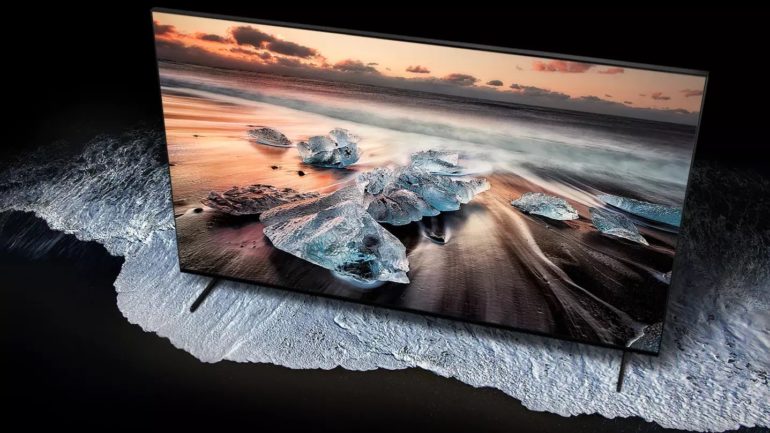What is QLED? If you’re looking for a new TV, you’ll need to know the answer to this question. But don’t worry, we’re here to demystify one of the many TV tech terms that often sounds much more confusing than it is and break down everything you need to know about QLED pixel by pixel.
Below we’ve included what QLED TV is, what to expect from QLED TV tech, how it’s different to other panel technologies that are currently on the market, including LCD and OLED devices, as well as whether this kind of TV tech is really the right option for you and your home.
First up, the most important (and unusual) thing about QLED is it’s a proprietary panel technology developed only for the very best Samsung TVs. You’ll find the ‘QLED’ label at a few other TV brands, namely TCL and Hisense, but generally, it refers to the tech inside a Samsung TV. These days it covers a few 8K TVs, too, such as the Samsung Q800T and the Q950TS, though most QLEDs available on the market right now are still 4K TVs.
The thing that sets QED panels apart from the rest is that they use a metallic quantum dot filter. This enhances both the color and contrast of the screen. What this means is the capabilities of HDR and 4K images are significantly boosted compared to other non-quantum dot LCD-LEDs.
However, there’s much more to QLED than just the fantastic screen. For example, QLED TV models now include Samsung’s Bixby virtual assistant, as well as an Ambient Mode, which helps them blend into your room better.
There’s more we could tell you about QLED, but you’ve just read the key elements of what makes a QLED TV a QLED TV. This should begin to demystify some of the marketing claims and specs about QLED TVs that you’ve likely seen when you’re researching TVs – and, importantly, help you work out which TV is right for you.
Today’s best QLED TV deals
Samsung Q70 Series 65-Inch…
QLED quantum dot FAQ
What is QLED? A TV panel technology used in Samsung TVs.Is QLED or OLED better? Depends who you ask. Check out this QLED vs OLED guide for more detail.Is QLED better than 4K? All QLED panels have a minimum 4K resolution – while some are even 8K.Are QLED TVs expensive? Some of them certainly are – though there are mid-range models that won’t break the bank, too.Is QLED really worth it? It’s a step up from Samsung’s regular Ultra HD TVs, that’s for sure – with incredible bright screens and strong upscaling ability. Everything else you need to know is in the rest of the guide below.
What is QLED?
Honestly? it’s a bit of a mystery. Literally, QLED means – or we suppose it means – quantum dot light-emitting diode. (That’s not to be confused with OLED, which refers to ‘organic light emitting diode’, and is a competing display technology we won’t go into detail on here.)
So what is a quantum dot light-emitting diode – or QLED – display, compared to a regular LCD television?
This Samsung concept is basically just the latest set of enhancements to the same quantum dot technology that the company has been working on for the past few years.
Technically speaking, Samsung’s QLED TVs are not QLED at all, well, at least in the way that we understand the term. A ‘proper’ quantum light-emitting diode element emits its own light – the clue is in the name – whereas Samsung’s latest TVs use a separate LCD backlight (and an edge-lit backlight, at that) just like any other LED-LCD TV. So where the QLED moniker comes from, we’re not sure.
How does a QLED TV work?
It’s complicated, but hang in there with us. So, to start, all QLED TVs have a quantum dot filter. It’s a film of tiny crystal semi-conductor particles that can be precisely controlled for their color output, which replace the red, green and blue color filters that old TVs used.
This filter now also uses an aluminum compound to help make the dots more efficient (and therefore brighter) and more effective at passing pass light through, which creates wider and more accurate color.
Samsung says that its QLED TVs use the new filters to display 100% coverage of the DCI/P3 color space (read: much deeper black levels and sparkling HDR), and maintain that performance whatever the brightness.
They’re so bright, in fact, that Samsung’s QLED TVs can manage up to 4000 nits peak brightness on its most premium sets. Considering 1000 nits is needed to produce HDR, that’s very bright, and far above the sub-1000 nit levels found on OLED TVs.
New advances in pixel panel structure also means that 2019 models and later are far better for off-axis viewing. For a living room environment, that could be QLED’s big selling point.
QLED vs LED
Beyond the ‘paradigm shift’ hyperbole of Samsung’s marketing, it’s really important to understand that QLED isn’t really anything new at all. In fact, it’s really nothing more than the latest – possibly among the last technically possible – tweaks to existing LED-LCD technology that’s dominated big screen TVs for the last decade.
QLED’s innovations – deeper blacks, better colors and wider viewing angles – tackle three traditional problems of LED and LCD technology, but they’re the same problems that are addressed year in, year out by TV makers. Only upcoming reviews will reveal if, in fact, QLED is a significant step forward from traditional LED-LCD screens – but chances are good that we’ll see some real improvements in these areas with Samsung’s new sets.
QLED vs OLED
Perhaps a more important comparison is QLED vs OLED. The latter uses pixels that emit their own light, but OLED displays are manufactured only by Samsung’s arch-rival LG, and now used by Sony, Philips and Panasonic, too.
There’s no doubt that QLED, for now, has an advantage in terms of brightness (so in theory may better handle HDR content – though might just as easily overcook it), but if you’re looking for a ‘paradigm shift’ in picture quality and the next-gen display technology, OLED is still the frontrunner. The latter uses individually lit pixels to achieve better contrast ratio and richer blacks that LED-LCD will never be able to hit, quantum dot filter or no. You can see the best of the bunch in our best OLED TVs roundup too.
What happened to SUHD?
QLED and SUHD are essentially the same thing; the new messaging is more about marketing than technology, although the jump from 1000 nits on the top-end SUHD TVs to 1,500 to 2,000 nits on the flagship QLED TVs – back in 2017, when Samsung started using the term – is perhaps more revolutionary than it seems at first.
Put simply, for a buying public still getting to grips with what UHD is, SUHD just proved too confusing, so Samsung has dropped it. (It also probably didn’t help that the ‘S’ in SUHD didn’t really mean anything… although we’re not convinced that QLED is much clearer.)
QLED price: how much does it cost?
Unlike OLED, which has a starting price of around $1,300 / £1,300 for its cheapest models, QLED caters to a host of price points, starting with the very cheap Q60T series.
The Q60T currently retails at just $540 / £540 for its smallest 43-inch size. Above that, you have the Q70T, Q80T, Q90T, and Q95T – with progressively higher price points for each increase in specification. Above that, of course, you have 8K models, with the UK-only Q700T starting at just £1,999, and the Q800TS, Q900TS, and Q950TS sitting above that. At the very top, you can buy the largest 82-inch / 85-inch sizes of the Q950TS for $12,999 / £11,999 respectively.
How long do QLED TVs last?
Samsung itself has given a likely time frame for its QLED televisions, saying that you can expect a QLED TV to last you roughly 7-10 years before you start to see some sort of visual degradation – while stressing that that includes the heavier use expected from smart TVs these days.
In this blog post, Samsung says that “On average, based on typical use, consumers should expect their TV’s picture quality to remain roughly the same for anywhere from seven to ten years.
“What’s interesting to note is that the definition of that term – ‘typical use’ – has expanded in recent years with the rise of binge-watching video and the development of exciting ‘smart TV’ functionalities. Now, on a typical day, we may switch on the TV to watch the latest episode of a favorite show, start a gaming session with friends, or manage our home’s IoT appliances.”
Should I buy a QLED TV?
Samsung’s QLED TVs are claimed to be all about the brightest possible, most accurate coloured images pictures, which therefore work with all kinds of content in all kinds of lighting conditions.
To an extent, those claims are true. The developments Samsung has made in recent years in improving QLED panels have made for some incredible high-end televisions, such as 2020’s Samsung Q95T QLED. And Samsung’s been sensible about using QLED as a by-word for premium hardware as well as brilliant picture quality.
That all seems a decent package for the living room, but whether you should buy a QLED TV will ultimately come down to price. You’re still paying thousands for a good QLED television, and the longevity of QLED may lie in how successfully Samsung can bring the technology to more mid-sized budgets. For now though, QLED offers a bright picture of what’s to come.
It’s worth noting that the most expensive and high specified QLED TVs these days are also 8K TVs, with four 8K models launching in 2020 and more certain to come in 2021. While 8K resolution isn’t quite a necessity yet, with little to no 8K content and a lot of hefty upscaling at work to keep low-res content looking pretty, it’s still an impressive technology that comes into its own at larger screen sizes. If you’re looking for a 75-inch TV, 8K might be a smart move.
Every 2020 QLED TV you can buy
SAMSUNG 43-inch Class QLED…
SAMSUNG 55-inch Class QLED…
Samsung 50 Inch TV 2020 QLED…
Samsung – 55″ Class Q90T…
SAMSUNG QN65Q800TAFXZA 65…
Samsung QN65Q900RBFXZA Flat…
Samsung – 85″ Class Q950TS…
Jamie Carter made original contributions to this article.



